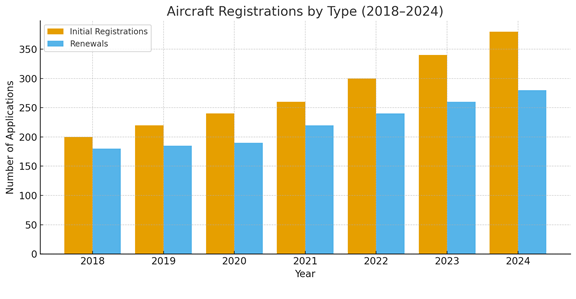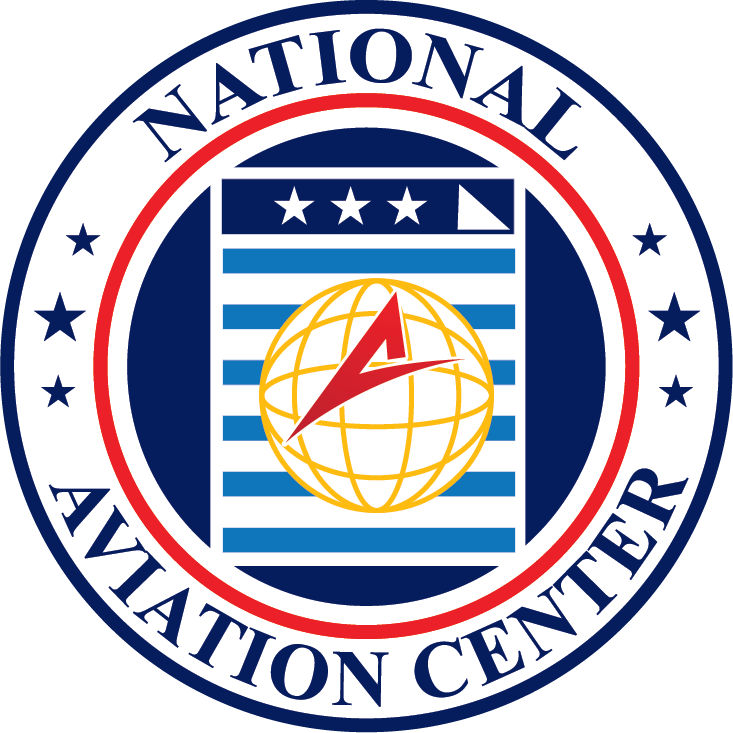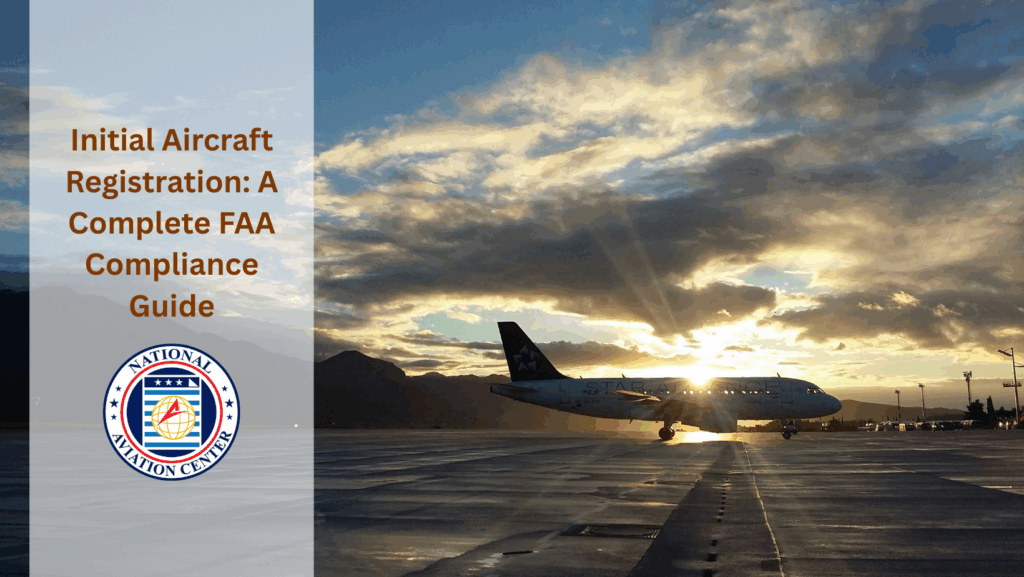You must initially register your aircraft through a procedure to operate your aircraft in the United States. All aircraft owners must register aircraft with the Federal Aviation Administration (FAA) before flight. Air safety and regulatory compliance have stewardship, accountability, and oversight. Whether you buy, import, or build aircraft, you will need to apply toward your Initial Aircraft Registration and there are specific requirements. This article provides information on applying for your registration, what is required and the procedures to complete registration in order to meet FAA compliance requirements.
What Is Initial Aircraft Registration and Why It Matters
Initial Aircraft Registration is the process of registering ownership of the aircraft and assigning it a unique registration number, normally referred to as the aircraft’s “N-number” (the official registration code for the aircraft in the FAA registry).
Importance of Aircraft Registration
| Purpose | Benefit |
| Legal Operation | Enables lawful flight within U.S. airspace. |
| Ownership Proof | Establishes the owner’s legal rights. |
| Safety and Tracking | Allows FAA monitoring for safety and compliance. |
| International Recognition | Required under international aviation standards (ICAO). |
Aircraft without active registration cannot obtain an airworthiness certificate or liability insurance or be legally flown under law.
When You Need Initial Registration
The Initial Aircraft Registration is to be applied for in the following instances:
- Buying a new or used aircraft that has never been registered in the U.S.
- Importation of a foreign aircraft into the country.
- Constructing a homebuilt or experimental aircraft.
- Recovering aircraft deregistered due to their export or destruction.
Register your aircraft soon so the aircraft can be correctly accounted for within FAA jurisdiction.
FAA Requirements and Documentation for Initial Aircraft Registration
When you initially register an aircraft with the FAA, certain necessary documents and processes to verify help the certification authority clearly picture the legal and operational status of your aircraft.

Essential Documents
The basic documentation required includes FAA Form 8050-1 Aircraft Registration Application and the Bill of Sale Form 8050-2, which shows the applicant legally owns the aircraft. The applicant must evidence U.S. citizenship. Fees for registration must cover application processing costs.
Additional Conditions
To qualify for registration:
- The aircraft must not be registered in another country.
- The owner must be a U.S. citizen or eligible corporation.
- The application must be signed in ink by the legal owner.
These measures are to prevent dual registration, as required by 14 CFR Part 47.
Step-by-Step Guide to Completing the Initial Aircraft Registration
The FAA process is set up to ensure each step is followed, and is properly traceable to show who owns the aircraft.
Step 1: Complete FAA Form 8050-1
The Aircraft Registration Application Form 8050-1 collects the following data below.
- Aircraft manufacturer and model.
- Serial number.
- Owner’s name and mailing address.
- Intended use category (private, commercial, etc.).
The form must be printed and filled out in black ink and mailed; electronic forms are not accepted.
Step 2: Submit the Bill of Sale
To establish proof of ownership transfer, you must attach FAA Form 8050-2. The buyer and the seller must sign on this form.
Step 3: Prove your U.S. citizenship with documents
The registrant must meet the requirements. Corporations and limited liability companies must apply, documenting the citizenship percentages among their owners.
Step 4: Pay the Registration Fee
A $5.00 (as of current FAA guidelines) processing fee must be submitted with each registration application.
Step 5: Prepare Application to the FAA Registry
Mail all forms and payments to:
- FAA Aircraft Registration Branch
- Oklahoma City, OK
Processing times typically range from 4–6 weeks depending on volume.
| Step | Description | Estimated Timeframe |
| Application Review | FAA verifies documentation accuracy | 5–10 business days |
| Ownership Confirmation | FAA cross-checks existing registry | 1–2 weeks |
| Certificate Issuance | Registration certificate mailed | 2–3 weeks |
Comparison: Initial vs. Renewal Aircraft Registration
However, to initially register an aircraft differs from renewing it.

- From 2018 onward, the number of registered aircraft has increased annually until 2024 because of new and imported aircraft.
- Renewals grow at a shallower rate. Renewals begin to accelerate from 2020. Several aircraft reach 3-year renewals.
- The gap between initial registrations and renewals has widened, which reflects the strength of initial demand.
- Initial registrations are projected to remain at their peak through 2024, showing growth.
The increase in new aircraft purchases and registrations shows the growth of general aviation.
Common Mistakes and How to Avoid Them
Inaccurate applications may cause delay in processing. Common inaccuracies by aircraft owners in the initial aircraft registration process include:
- FAA Form 8050-1 does not include complete information because it misses manufacturer information or presents incorrect serial numbers.
- Unsigned Bill of Sale – Both parties sign it to prove ownership.
- Ineligible Entity Application – Verify registrant meets the FAA’s citizenship requirements.
- Incorrect Mailing Address – Certificates may be delayed or lost in the mail.
Common Errors in Aircraft Registration and How to Resolve Them
Where the ownership of the aircraft cannot be proved, and no proof is attached, the application for the registration may be rejected. FAA Form 8050-2 proves ownership. Mismatched serial numbers do not show up in registry. Factory documents with correct serial numbers must be submitted. Missing signatures will lead to delayed approvals, when needed. All documents must be signed, as necessary. If foreign registration overlaps, a legal conflict arises, and the aircraft deregisters from the foreign authority before applying.
If you avoid these mistakes, the registration proceeds along without delay or compliance issues.
Case Example: Successful Initial Registration
The private pilot obtained the light aircraft through an importer then completed FAA Form 8050-1 in addition to including a bill of sale plus proof of citizenship afterward the pilot sent the documents to the FAA in Texas.
Outcome:
- FAA approved the application in three weeks.
- The FAA assigned the aircraft its N-number.
- The owner carried insurance and received authorization to fly.
This case also shows the importance of timely and complete submissions.
Practical Tips for Efficient Initial Registration
Here are some items that are good to look for:
- Check documentation before submitting.
- Send a request to the FAA, certified mail with a return receipt requested.
- Keep copies of all forms and receipts for your payments.
- Verify deregistration if purchasing from outside the U.S.
Tip & Benefit
- Accurate records will speed up future renewals.
- Track applications to ensure they are not lost.
- Consulting aviation law experts to meet regulatory requirements.
- Proper preparation avoids costly delays on every project.
Adherence to these criteria will ensure a smooth certification process.
The Legal and Operational Significance of Initial Aircraft Registration
Aircraft registration acts as a means of identifying the owner and as a basis of accountability.
Legal Framework
Register with the FAA under 14 CFR Part 47 before you operate any aircraft. Registration certificates must be kept inside of the cockpit and be readily accessible.
FAA Enforcement and Penalties
Operating an unregistered aircraft can cause things like:
- Civil penalties reach $25,000.
- Suspension of flight operations.
- Revocation of airworthiness certification.
The Foundation of Legal and Safe Aircraft Ownership
At National Aviation Center, All aircraft owners must first fill out the Initial Aircraft Registration in order to establish legal title, to register their aircraft with the FAA and to allow it to operate in controlled airspace.
If registrants provide adequate documentation, remain eligible, and follow the FAA’s process, then owners are likely to have a smooth registration experience.
It is not just a matter of complying with formalities but an affirmation of responsibility, safety and the highest air governance standards.




